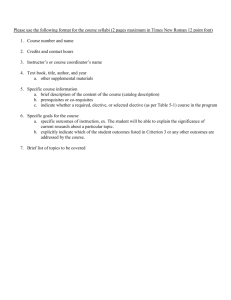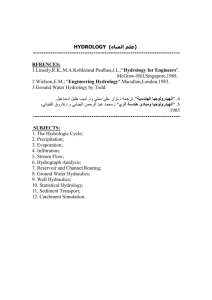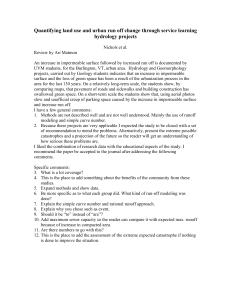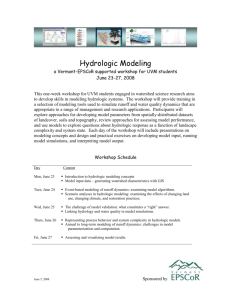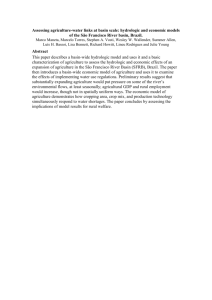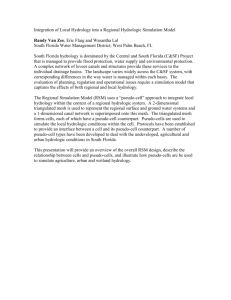No Slide Title - UW Hydro | Computational Hydrology
advertisement
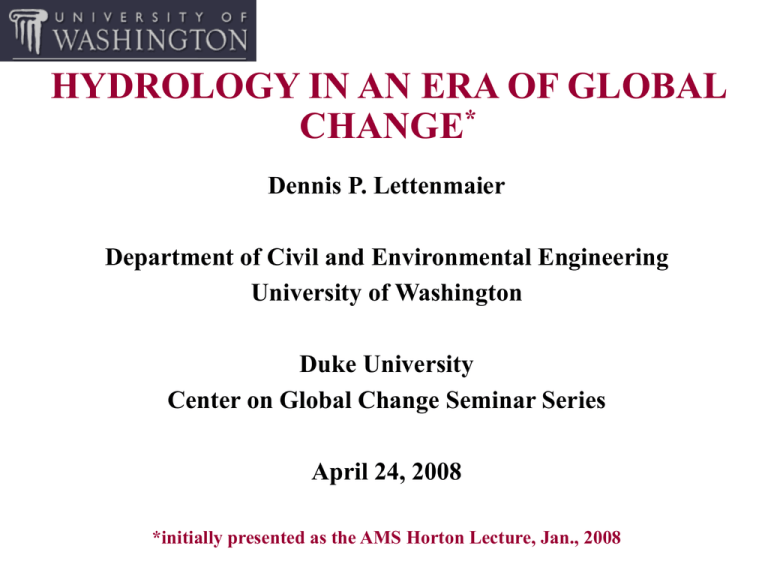
HYDROLOGY IN AN ERA OF GLOBAL CHANGE* Dennis P. Lettenmaier Department of Civil and Environmental Engineering University of Washington Duke University Center on Global Change Seminar Series April 24, 2008 *initially presented as the AMS Horton Lecture, Jan., 2008 With thanks to the University of Washington Land Surface Hydrology Group UW LAND SURFACE HYDROLOGY RESEARCH GROUP 2008 Hulin Gao Amanda Tan Fransisco Munoz Ted Bohn Tazebe Beyenne Kristian Mickelson Shrad Shukla Alan Hamlet Quihong Tang Mergia Sonessa Dennis Lettenmaier Ben Livneh Andrew Wood Kostas Andreadis Chunmei Zhu Lan Cuo John Yearsley Nathalie Voisin Xiaogong Shi Elizabeth Clark And especially: Kostas Andreadis (UW) Tazebe Beyenne (UW) Elizabeth Clark (UW) Lan Cuo (UW) Mariza Costa-Cabral (Hydrology Futures, Seattle) Ingjerd Haddeland (Norwegian Water Resources and Energy Directorate) Hugo Hidalgo (Scripps Institution of Oceanography) Ben Livneh (UW) Ramiro Saurral and Vicente Barros (University of Buenos Aires) Amanda Tan (UW) Robert E. Horton (1875-1945) • Published 100-200 papers (no known bibliography) • Best known for 1933 Trans AGU paper “The role of infiltration in the hydrologic cycle” • However, much of his early work (e.g., MWR, 1905) dealt with snow hydrology • 24 papers appeared in MWR, earliest in May 1905, last in Apr. 1934 • Last papers appeared shortly before his death, e.g. “Erosional development of streams” (Trans GSA, 1945) • Comments in Science (Dec. 10, 1937) “Hydrology research”: All hydrologic phenomena are in reality physical phenomena and are governed by the fundamental laws of physics. Many otherwise excellent hydrologic researches have suffered from lack of adequate consideration of the physical processes involved and from the failure to use mathematical methods. Water balance of the continental U.S., from “Hydrologic interrelations between lands and oceans,” Robert E. Horton, Trans AGU, 1943. Aggregated Maurer et al. (2002) data vs Horton (1943) What are the “grand challenges” in hydrology? • From Science (2006) 125th Anniversary issue (of eight in Environmental Sciences): Hydrologic forecasting – floods, droughts, and contamination • From the CUAHSI Science and Implementation Plan (2007): … a more comprehensive and … systematic understanding of continental water dynamics … • From the USGCRP Water Cycle Study Group, 2001 (Hornberger Report): [understanding] the causes of water cycle variations on global and regional scales, to what extent [they] are predictable, [and] how … water and nutrient cycles [are] linked? Important problems all, but I will argue instead (in addition) that understanding hydrologic sensitivities to global change should rise to the level of a grand challenge to the community. In an era of global change … • What are the impacts of land use and land cover change on river basin hydrology? • What is the climatic sensitivity of runoff? • What are the impacts of water management on the water cycle? 1. Land cover/land use change effects Global cropland expansion, 1700-1992 (from Ramankutty and Foley, Global Biogeochem. Cycles, 1999) Do we understand the sensitivities? Case study 1: Vegetation and climate change effects on streamflow in the Uruguay River basin 1990s land cover (U MD) Global Potential Vegetation (Ramankutty and Foley) Forest/Woodland Uruguay River basin land cover change – potential vegetation vs 1990s Shrubland/grassland Cropland Simulated and observed streamflows, Uruguay River at Concordia, Uruguay – calibration (1995-99) and verification (1990-94). Visual courtesy Ramiro Saurral and Vicente Barros, University of Buenos Aires Simulated and observed mean monthly flows at Concordia, 1990-99 for ~1990 land cover, and sensitivity to land cover change (forest type 7; grassland type 10) Visual courtesy Vicente Barros and Ramiro Saurral, University of Buenos Aires Predicted and observed Concordia discharge, decade of 1960s (upper) and 1990s (lower), both simulations using 1990s vegetation, and consistent observing network for two decades. Visual courtesy Vicente Barros and Ramiro Saurral, University of Buenos Aires Case study 2: Land cover change in the Mekong River basin EXPANSION OF RICE PADDIES 10 km The broad low land along the Mun River was drained for more irrigated rice. The 1946 interfluves of tributaries of the Mun and Chi were converted to (bunded) rainfed rice. AREA OF DETAIL 1984 100 km From: Fukui et al., Global Environ. Res. 3 (2), 2000. Predicted streamflow trends •In the dry season (Nov-Apr), cultivation is limited, and ET from cropland is far less than from forest. The simulated change from forest to cropland agrees with observations for 1962-2000 (~120% increase). Mainstem wet season •In the wet season (May-Oct), simulated evapo-transpiration from bunded rice paddies is large but does not quite reach that of forest. dry season Mun-Chi sub-basin Chiang Vient. Muk. S P O Saen downstream distance Chiang Saen Yasothon (Chi) Chi Chi Mun Mun dry season wet season Rasi Salai (Mun) Ubon downstream distance Yasothon (Chi river) Rasi Salai (Mun river) Ubon Junction Vientiane Mukdahan Pakse Stung Treng (S) Phnom Penh (P) Outlet (O) OBSERVED STREAMFLOW TRENDS: Percent Change in Monthly Flows Per Year in 1962-2000 (based on the Mann-Kendall test for trends) 4 Chiang Saen Vientiane minus Chiang Saen Mukdahan minus Vientiane Pakse minus Mukdahan Ubon Yasothon Stung Treng minus Pakse Trend Slope as % of Month's Average 3 2 1 Streamflows from Northeast Thailand show fast-rising trends in the dry season months (Winter). 0 jan -1 -2 -3 -4 feb mar apr may jun jul aug sep oct nov dec Streamflows from Laos show decreasing trends in the dry season months (Winter). Chi River (Yasothon): A ~3% increase per year in dry-season streamflow leads to a ~120% increase (more than a doubling) in the 40 years from 1962 to 2000. Case study 3: Land cover change in an urbanizing catchment, Mercer Creek, WA Mercer Creek (~31.1 km2) land cover, 1882 and 2002 1882 2002 Mercer Creek annual flows 1955-2006, and double mass curve 2. What is the climatic elasticity of runoff? 19-model GCM average, Colorado River basin, annual values 2001-2100 Replotted from Seager et al., Science, 2007 Dooge (1992; 1999): where and (Budyko curve) Special cases: a) AE = constant: ΨP = P/Q (inverse of runoff ratio) b) P/PE large (e.g., tundra): ΨP = 1 c) P/PE small (desert): depends on Φ’(0) (but ΨP ~ 3 for some forms) Precipitation sensitivity is straightforward Evapotranspiration, however, depends on net radiation and vapor pressure deficit (among other variables), whereas (air) temperature is the more commonly observed variable Air temperature in turn, affects (or is affected by): • • • • downward solar and (net) longwave radiation sensible and latent heat fluxes ground heat flux snowmelt timing (and energy fluxes) Hence, it may be more useful to consider temperature sensitivity Two approaches to estimating sensitivities: a) From observations (with inherent record length, and perhaps stationarity complications) and b) From models (with inherent model dependence) ΨP over the continental U.S. (from Sankarasubramanian and Vogel, WRR, 2001) Precipitation elasticity ΨP as a function of Budyko humidity index over the continental U.S. •Upper plot: Hydrologic regions 1, 3, 12 (New England, SE, Texas) •Lower plot: Hydrologic regions 10 and 17 (Missouri and Pacific NW) Source: Sankarasubramanian and Vogel, WRR, 2001 Precipitation elasticity ΨP as a function of mean accumulated snow depth Source: Sankarasubramanian and Vogel, WRR, 2001 Bivariate Precipitationtemperature sensitivities inferred from naturalized Colorado River streamflows at Lees Ferry, and from simulated Lees Ferry flows observed simulated Visual courtesy Hugo Hidalgo, Scripps Institution of Oceanography Bivariate Precipitationtemperature sensitivities inferred from naturalized Colorado River streamflows at Lees Ferry, annual and winter T Observed – annual T Observed – winter T Visual courtesy Hugo Hidalgo, Scripps Institution of Oceanography Bivariate Precipitationtemperature elasticities inferred from naturalized Colorado River streamflows at Lees Ferry, and from simulated Lees Ferry flows Visual courtesy Hugo Hidalgo, Scripps Institution of Oceanography Precipitation elasticity as a function of precipitation difference (T = 0) from Colorado River at Lees Ferry naturalized annual flows, 1905-2006. Upper plot unsmoothed, lower smoothed. Annual basin precipitation elasticity from VIC model (20year simulation), with +10% precipitation increase (~1.9 for basin at outlet) Elasticity Runoff sensitivity to 1o C increase in Tmin and Tmax (downward solar radiation constant) Runoff from cells with negative sensitivity Runoff from cells with negative sensitivity Spatial distribution of runoff sensitivity to 1o C increase in Tmin and Tmax (downward solar radiation constant) Basin aggregate: 2.2% per oC Runoff sensitivity to 2o C increase in Tmax and no increase in Tmin (changes both vpd and downward solar radiation) Basin aggregate: 3.3% per oC So is there, or is there not, a dichotomy? Very roughly, mid-century ΔP 18%, so for = 1.51.9, and temperature sensitivity 0.02-0.03, and ΔT 2 oC, ΔQ 35% (vs > 50% + from GCM) More important, though, is the question: does the land surface hydrology matter, or does the land surface just passively respond to changes in the atmospheric circulation? i.e., in the long-term mean, VIMFC P-E Q, so do we really need to know anything about the land surface to determine the runoff sensitivity (from coupled models)? OR is the coupled system sensitive to the spatial variability in the processes that control runoff generation (and hence ET), and in turn, are there critical controls on the hydrologic sensitivities that are not (and cannot, due to resolution constraints) be represented in current coupled models? 3. What are the impacts of water management on the water cycle? Construction of dams has vastly altered the water cycle by: •Altering the seasonal cycle, and annual amount of discharge (6 major global rivers, including the Colorado, no longer flow at their mouths) ~1900 •Increasing the time of travel through the channel system •Changing the quality of rivers, and constituents and physical characteristics of continental river discharge •Transporting water within and between rivers basins, and altering its partitioning (usually meaning increased evapotranspiration) 2000 Reservoir construction has slowed. 800 . 700 Number of Reservoirs 600 500 Australia/New Zealand Africa Asia Europe Central and South America North America 400 300 200 100 0 Up to 1901- 1911- 1921- 1931- 1941- 1951- 1961- 1971- 1981- 19901900 1910 1920 1930 1940 1950 1960 1970 1980 1990 1998 All reservoirs larger than 0.1 km3 Some examples Columbia River at the Dalles, OR Historic Naturalized Flow Estimated Range of Naturalized Flow With 2040’s Warming Regulated Flow Figure 1: mean seasonal hydrographs of the Columbia River prior to (blue) and after the completion of reservoirs that now have storage capacity equal to about one-third of the river’s mean annual flow (red), and the projected range of impacts on naturalized flows predicted to result from a range of global warming scenarios over the next century. Climate change scenarios IPCC Data and Distribution Center, hydrologic simulations courtesy of A. Hamlet, University of Washington. Colorado River basin Irrigation water requirements Evapotranspiration increase mm 0 100 200 Changes in latent heat fluxes Wm-2 Percent 0 50 100 Changes in sensible Changes in surface heat fluxes temperatures 0 10 20 °C Wm-2 -30 -20 -10 0 -1.5 -1.0 -0.5 0 • Figure: Results for three peak irrigation months (Jun, Jul, Aug), averaged over the 20-year simulation period. • Max changes in one cell during the summer: Evapotranspiration increases from 24 to 231 mm, latent heat decreases by 63 W m-2, and daily averaged surface temperature decreases 2.1 °C • Mean annual “natural” runoff and evapotranspiration: 42.3 and 335 mm • Mean annual “irrigated” runoff and evapotranspiration: 26.5 and 350 mm Colorado River basin – modelled effects of irrigation on moisture and energy fluxes Irrigation water requirements Evapotranspiration increase mm 0 100 200 ● ● ● ● Changes in latent heat fluxes Wm-2 Percent 0 50 100 Changes in sensible Changes in surface heat fluxes temperatures 0 10 20 °C Wm-2 -30 -20 -10 0 -1.5 -1.0 -0.5 0 Figure: Results for three peak irrigation months (Jun, Jul, Aug), averaged over the 20-year simulation period. Max changes in one cell during the summer: Evapotranspiration increases from 24 to 231 mm, latent heat decreases by 63 W m-2, and daily averaged surface temperature decreases 2.1 °C Mean annual “natural” runoff and evapotranspiration: 42.3 and 335 mm Mean annual “irrigated” runoff and evapotranspiration: 26.5 and 350 mm Our typical approach to modeling water management effects within the land hydrological cycle Atmospheric forcing (gridded observations, or downscaled from weather or climate model) Hydrology Model Water Management Model Some thoughts on the institutional setting • International programs The role of WCRP (and especially GEWEX) and the need for reinvention • Funding agencies The impact of decisions by program managers, and the need for more community involvement in the setting of priorities “The most general problem is … the transition from a qualitative to a quantitative science ..” (Horton, “The field, scope, and status of the science of hydrology,” Trans. AGU, 1931) Conclusions •We need to understand hydrologic sensitivities – to vegetation and climate change – better. There is a compelling motivation to do so both from a scientific and societal need basis. •We need a more scientific approach to understanding the feedbacks and implications of water management and anthropogenic perturbations on the water cycle •The time has come to rethink international programs related to land hydrology, and related U.S. funding priorities and mechanisms
